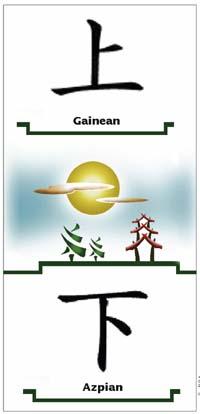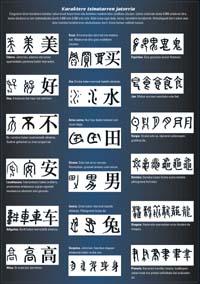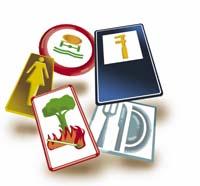Ideograms and pictograms

It is only an example, but very representative. It clearly explains how an idea can be expressed using a single symbol. A symbol, a concept. It does not seem to be a very effective writing system, since thousands of symbols or characters are needed to express thousands of concepts. However, there are other types of examples in Chinese.
The simplest of these examples is the pictogram: it is the drawing of those who want to express the character. The symbol of the turtle, for example, is the drawing of a turtle (of course, transformed in time). Ideograms are more complex because, in addition to the drawing, they use a small history to express an abstract idea. This is the symbol of the child under cover, as well as that of light: The Moon and the Sun together.
Both types of symbols have a clear advantage. Since they are not related to pronunciation, that is, they do not refer to certain sounds, they can serve for any dialect of Chinese. Despite pronouncing one way in each dialect, everyone can read what is written. Ideograms and pictograms are or can be universal. However, Chinese does not use only pictograms and ideograms.
Phonetics in the interval

The symbols that encode the sounds are typical in the Chinese, the most common in all of them. They are formed by two symbols, the first gives meaning to the symbol and the second indicates how it is pronounced.
The character that represents the mother is an example of it. Apparently it is a unique symbol, but it has two parts: the one on the left is the symbol of the woman; the one on the right, on the contrary, is a horse, but in this case it has a phonetic value: It is pronounced /ma/ indicating in this case that the full sign /ma/ is read. Another example is the representative character of the butterfly: the symbol on the left is that of the insect and the one on the right is /hu/ pronunciation.

On this path the combination completes 90% of the characters that appear in the Chinese dictionaries, but there are also other types of characters, such as the 'indicative' characters, which are indicated above and below (of course, all characters indicate something, but serve to write concepts that are not written by pictograms and ideograms).
As in all languages, they also have words of loan. In these cases, they almost always combine characters to express new meanings. To express the computer, for example, the symbols of the brain and electricity have been combined: the electric brain. It is easy and clear, and in this way, the character of the computer does not require learning new pronunciations. The evolution of Chinese in this character is clear: at first they were taken from the calculation machine, but over time they opted for the electric brain for being more comprehensible.
They also use phonetic tricks to make loans. To write the word Washington, for example, combine three phonetic characters corresponding to /wah/, /sing/ and /dun/ syllables. Of course, western languages have lent several Chinese words along the same way, such as typhoon.
Outside of China

Japan and Korea have taken many characters from Chinese writing, called Kanji and Hanja respectively. Many of the ideograms of these systems have remained in these villages with an ancient "unevolved" form and others have been created there. But in addition, the writings of both peoples use systems of phonetic syllables, very simplified ideograms.
In Japan they use two systems, the so-called trident and catacanes, which are mainly used with words of loan.
The writings of the eastern peoples, therefore, are not simple ideograms, but they also have very much worked the phonetic side of words. In China, too, a special effort is made to encode sounds, and no wonder, languages are very changing and have to adapt quickly to writing, in which syllables and letters help a lot.

Number of characters
At the beginning of the Qing dynasty in China, XVII. In the twentieth century, 50,000 characters were collected in a dictionary. Later, with the years, this figure was reduced considerably. Currently, a Chinese cult knows about 6,000 characters and computer systems have coded approximately 6.500. This number of Hong Kong and Taiwan is double 13,000 characters.
The alphabets of western writing have fewer characters. They usually use 27 uppercase letters, 27 lowercase letters, 10 numerical signs, punctuation signs (dot, coma, question mark, etc.) and symbols of each language (accents or special letters, etc. ). In addition, symbols created or, at least, internalized in recent years, such as @, to which we should perhaps add mathematical symbols, etc. Despite all this, the western scriptures use about 100 characters, with which we can write practically any concept.

From this point of view there is no doubt that Western alphabets are much more efficient than Eastern character systems. Surely it is true, and that is why oriental writing is being simplified and, to the extent that tradition allows it, introducing symbols or phonetic characters. But things are not so simple.
Western pictograms

In addition, western people live surrounded by pictograms and ideograms. Pedestrian traffic lights consist of two ideograms: one authorizes the passage of the road and the other prohibits it. They are not regulated ideograms, but they are understood. The male and female drawings that are placed in the doors of the bathroom are, in short, ideograms. And there are many other examples.
The West also needs ideograms and pictograms. They are within a writing system, not always regulated, nor always within a text, but they exist. The child under cover, the ideogram, is exposed worldwide, always adapted to the needs of the place.
Buletina
Bidali zure helbide elektronikoa eta jaso asteroko buletina zure sarrera-ontzian










